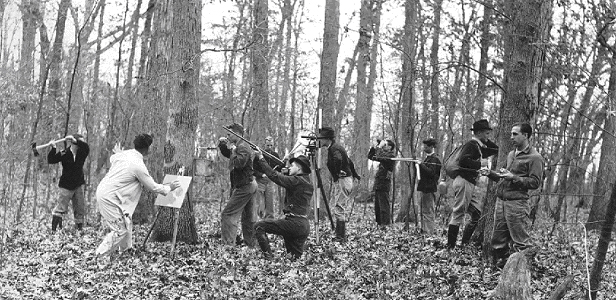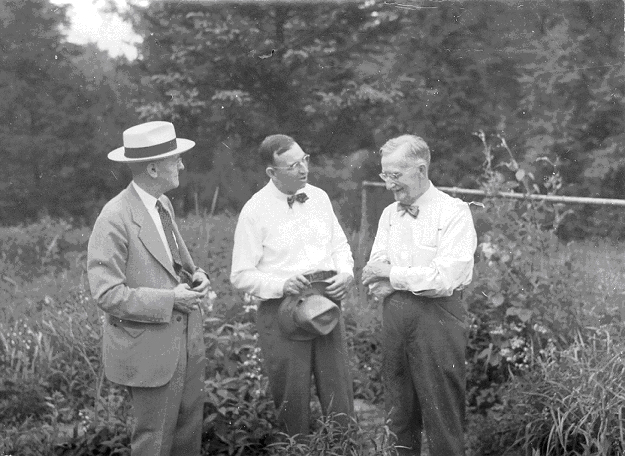The Department of Forestry and Natural Resources at Purdue University –
Celebrating 100 years
By Bill Hoover
The formation of Purdue’s Department of Forestry was driven by the same factors that led to the establishment of the State Board of Forestry (House Bill 192, Approved March 1, 1901). It became the Division of Forestry in March 1919 under the leadership of Col. Richard Lieber. Purdue Professor of Biology, Stanley Coulter, represented Purdue in the many efforts made to improve the forests of Indiana during these formative years. He was a member of the State Board of Forestry from its formation until 1935. He is the founder of Purdue’s forestry program. The factors influencing his interest in forestry and the profession of forestry are the story of forestry in Indiana from 1890 until the early 1930’s.
Stanley Coulter, Professor of Biology, and later Dean, School of Science, and first Dean of Men, was directly responsible for the first forestry course offerings and creation of an elective forestry curriculum. His field of science was botany specializing in taxonomy. His interest in the taxonomy of tree species expanded to forestry in general and the need to practice forestry in Indiana. He published a series of articles in the Annual Reports of the State Board of Forestry identifying the condition of farm woodlots, needed improvements, and an outline for their management. Articles started in the 1903 Report although the authors are not identified. The first article under his name was “Forestry--Its Influence upon Animal and Plant Distribution,” Sixth Annual Report, State Board of Forestry, 1906, pp. 80-84. His later articles focused on the state of farm woodlots and the need for management based on their economic value to the farm enterprise and cash income from the sale of timber to Indiana’s growing forest products industry. He used extension publications from Cornell University and frequently cited articles in American Forests magazine. It was first published in 1895. He authored a series of scientific papers on forestry published in the Proceedings of the Indiana Academy of Science during the period 1891-1926. This literature made him aware of the start of professional forestry training in the east, first at the Biltmore School and Cornell (1898) and shortly thereafter at Yale (1900).
His interest in forestry led him to start teaching forestry courses in the Department of Biology at Purdue starting in the 1905-06 school year. By 1913-14 course offerings included a two-semester sequence covering Forest Botany, elements of Silviculture and Forest Mensuration, all taught by Prof. Coulter. Later courses covered additional topics, including Forest Zoology. Burr N. Prentice was hired as an instructor in forestry in 1914. At this time forestry courses were listed as such in the catalogue. Previously they were listed as biology courses. In 1926 Forestry was shifted from the School of Science and established as a department in the School of Agriculture. Under the invitation of the Head of the Department of Horticulture the new Department of Forestry was housed in the new Horticulture Building. It was located there until the early 1970’s when it was moved to Ag. Annex I. A very progressive class for Purdue forestry students. Here they demonstrate for the camera multiple-use forest management (FNR Archives)
A very progressive class for Purdue forestry students. Here they demonstrate for the camera multiple-use forest management (FNR Archives)
In order to put the new forestry program into context, Dean of Agriculture Skinner asked Burr Prentice to survey other land-grant universities to determine enrollment in forestry and the number of faculty providing forestry instruction at the undergraduate level. While the survey was underway Burr Prentice corresponded with Ralph F. Wilcox, the acting state forester. Wilcox candidly told Prentice, “Your graduates are seriously handicapped both as applicants for positions and as foresters entering the practical field by their having very little actual forestry experience.” Prentice made Skinner aware of this issue who in turn informed President Elliott, noting that “one of the greatest weaknesses of the students in Forestry that have been turned out of this institution in the past has been their lack of practical knowledge of Forestry. It is deemed desirable and essential that they get this in a camp established for freshmen. All the more prominent institutions offering Forestry have summer camps for Forestry students.”
The president and trustees supported Skinner’s request. All entering freshmen starting in 1926 were required to attend an eight-week summer forestry camp at Henryville, Indiana. The first camp was held in the summer of 1929, allowing all the students enrolled in the forestry program to participate. Several years later President Elliott and Dean Skinner came to Henryville to observe instructional activities.
Dean Coulter’s interest in trees and forestry benefited from collaboration with Charles Deam. Charles Deam’s interest in botany derived from the use of plant materials in his pharmacy practice. John S. Wright, an employee of Eli Lilly Company, had similar interests. Their shared interests are demonstrated by their publications in the Indiana Academy of Science, as was John S. Wright’s. Dean Coulter’s older brother, John Merle Coulter was a nationally recognized and widely published botanist and President, Indiana University, from 1891 to 1893. It’s reasonable to assume that John’s interactions with his brother Stanley, Charles Deam and John Wright influenced the work of all three.
Professor Prentice found time to conduct the first inventory of Davis Farm Woodlot (Prentice B, 1927. Forest survey no. 1: Herbert Davis Forestry Farm. Unpublished report to the Department of Forestry and Conservation, Purdue University, West Lafayette, IN). The Davis Woods remains to this day Indiana’s oldest and most studied old-growth forest. Other research was very applied, focusing on regeneration and woodlot management techniques. Much of this work was conducted on Indiana’s first forest reserve, now Clark State Forest. There was a need for research justifying an ongoing effort to “get the cows out of the woods,” and hogs, horses, and other grazing animals. A series of research bulletins of the Agriculture Experiment Station reports on this research. John S. Wright, John E. Seybert, and Charles C. Deam, June 1944 (Photo by Frank N., Wallace, FNR Archives Accession No. CCD.MISC.PRI012)
John S. Wright, John E. Seybert, and Charles C. Deam, June 1944 (Photo by Frank N., Wallace, FNR Archives Accession No. CCD.MISC.PRI012)
The Department of Forestry was renamed the Department of Forestry and Conservation in 1956, and renamed Forestry and Natural Resources in 1974. The forestry program was first accredited by the Society of American Foresters in 1942. A curriculum in Wood Technology and Utilization was added in 1945. Wildlife instruction began in the Department of Biology in the 1926-27 school year. Instruction moved to the Department of Forestry in 1934. Fisheries and aquatic science work was initiated in 1969 with work focused on the Wabash River.
The Department continues to grow in the output of research results, extension programs, and the quality of undergraduate and graduate education. Over the last 10 years enrollment in forestry counting all four years averaged a little over 50 until 2011 when it declined to about 45. The number of forestry graduates does not meet the demand from employers. Enrollment in wildlife science peaked at over 300 in 2010 and decline to 260 in 2012.
The future of the department is very good in large part because of the faculty’s ability to adapt to changes in society in general and the need for natural resource and environmental science information to inform policy decisions and advance the science of applied ecology. The Centennial of Purdue University’s Department of Forestry and Natural Resources is a celebration of the lives of our graduates and the role FNR played in them. There will be celebratory activities on campus from September 20 to 22, 2013, but we hope this is just a small part of the celebration. Alumni and friends are encouraged to visit https://ag.purdue.edu/fnr/100/Pages/default.aspx for information and how to participate.
Dr. William Hoover is a Professor of Forestry in the Department of Forestry and Natural Resources at Purdue University. He is Chair of the Centennial Committee which is summarizing the Department’s history and planning the centennial celebration later this year.
